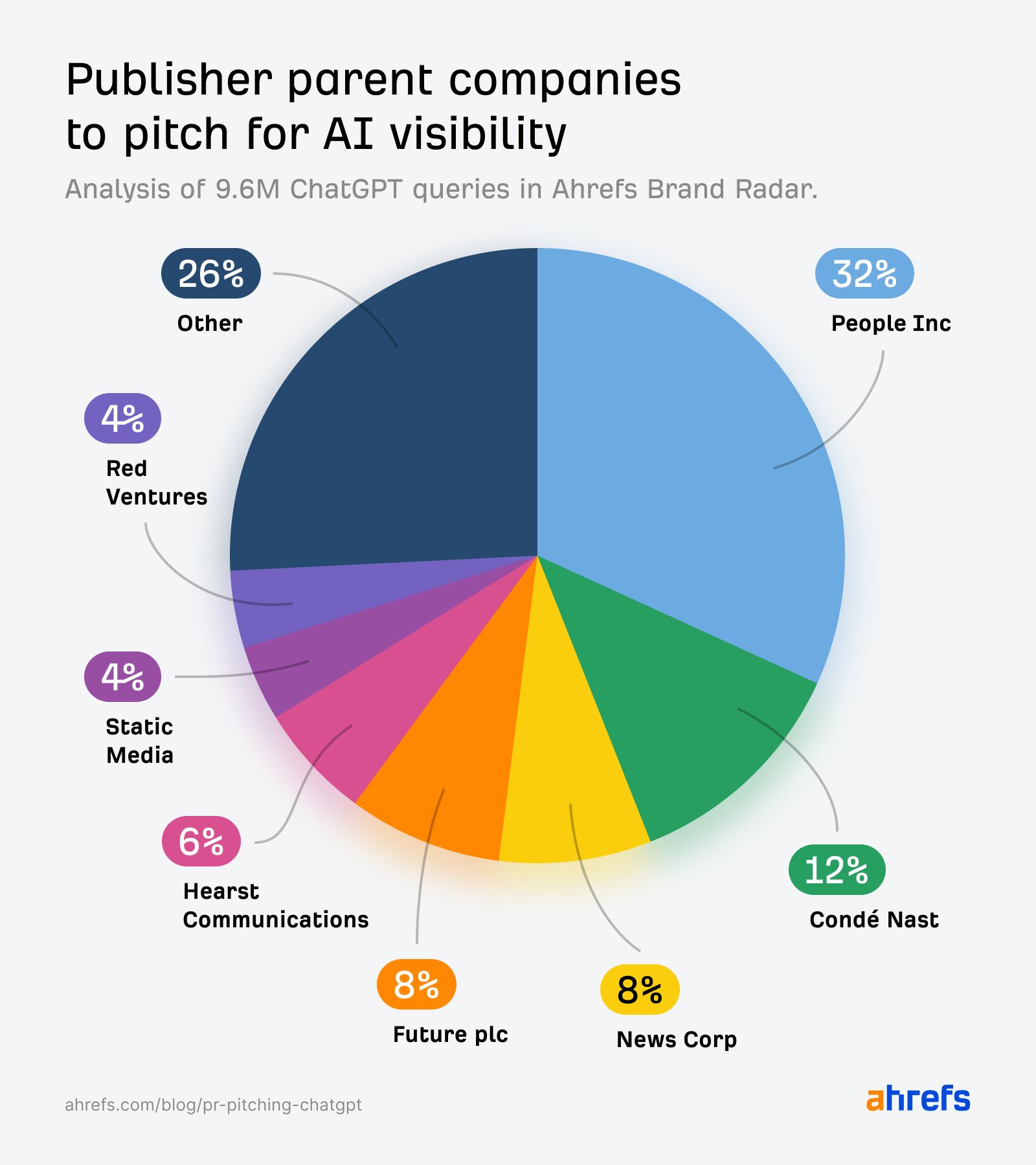🚀 Unlocking PR Success with AI Insights
This article explores how to harness AI-driven data to enhance your public relations (PR) strategy, focusing on the most cited publishers in AI responses like those from ChatGPT. Inspired by insights from Louise Linehan’s article on Ahrefs, we use tools like Ahrefs Brand Radar to uncover actionable pitching opportunities to boost your brand’s visibility.
✨ Why AI Citations Matter for PR
AI platforms, such as ChatGPT, rely on trusted, authoritative sources to generate responses. Getting your brand featured in these sources not only reaches their human audiences but also increases your chances of appearing in AI-generated answers, amplifying your brand’s reach across search engines, social media, and AI platforms.
Here’s what makes this approach powerful:
🔗 Key Benefits of AI-Focused PR
- Increased Visibility: Being cited by top publishers enhances your brand’s presence in AI responses.
- Multi-Channel Impact: Coverage in high-authority outlets boosts your brand across search, social, and AI platforms.
- Niche Relevance: Targeting industry-specific publishers ensures your brand resonates with the right audience.
Source: The 50 Best PR Pitching Opportunities in ChatGPT by Louise Linehan
📋 Top Publishers for PR Pitching
Drawing from Ahrefs Brand Radar data, which analyzed 9.6 million ChatGPT queries, we identified the top 50 publishers most frequently cited in AI responses. These outlets are prime targets for PR pitches due to their high visibility and authority.
Top 10 Publishers Cited in ChatGPT
- Forbes
- Business Insider
- The Spruce
- New York Post
- Better Homes & Gardens
- Wired
- People
- TechRadar
- Tom’s Guide
- Real Simple
Parent Companies Dominating AI Citations
- People Inc.: Owns 16 of the top 50 cited publishers, including The Spruce, InStyle, and Health.com.
- Condé Nast: Includes Wired, Vogue, and GQ.
- Future plc: Features TechRadar and Tom’s Guide.
- News Corp: Includes New York Post and The Sun.
Credit: Data sourced from Louise Linehan’s analysis on Ahrefs.
💬 Strategic Insights for PR Success
“To win in PR, target outlets that dominate AI citations and align with your brand’s niche.”
— Inspired by Louise Linehan, Ahrefs
Here’s how to make the most of this data:
1. Focus on High-Impact Publishers
Outlets like Forbes, Business Insider, and The Spruce are consistently cited in ChatGPT responses, making them ideal for pitching. Their broad reach ensures your brand gains visibility across multiple platforms.
2. Target Niche-Specific Outlets
Industry-focused publishers, such as Car and Driver for automotive or Architectural Digest for design, offer strong AI visibility within specific sectors. These are perfect for brands aiming to connect with targeted audiences.
3. Leverage Parent Company Networks
Parent companies like People Inc. and Condé Nast often syndicate content across their publications. Pitching to one outlet in their network can lead to broader exposure.
4. Explore Alternative PR Channels
Some publishers, like PR Newswire, syndicate press releases, while others, like WebMD, feature expert contributions. These avenues provide additional ways to boost your brand’s AI visibility.
🖼️ Visualizing the Data
Here’s a breakdown of the top parent companies cited in ChatGPT responses:

Source: Visual inspired by Ahrefs Brand Radar data.
🧑💻 How to Identify PR Opportunities
To find the best pitching opportunities, follow these steps:
1. Analyze Competitor Citations
Use Ahrefs Brand Radar to identify publishers citing your competitors but not your brand. For example, if Asana is cited in TechRadar and Forbes, but your brand isn’t, these are prime pitching targets.
// Example: Filter competitors in Ahrefs Brand Radar
function findCompetitorCitations() {
const filters = {
include: "competitor_brand",
exclude: "your_brand",
platform: "ChatGPT"
};
console.log("Fetching publishers citing competitors...");
}
findCompetitorCitations();